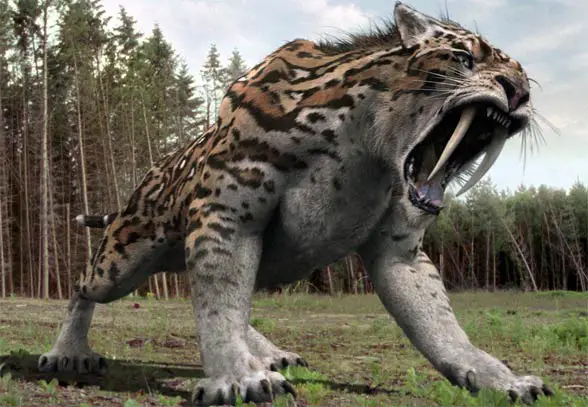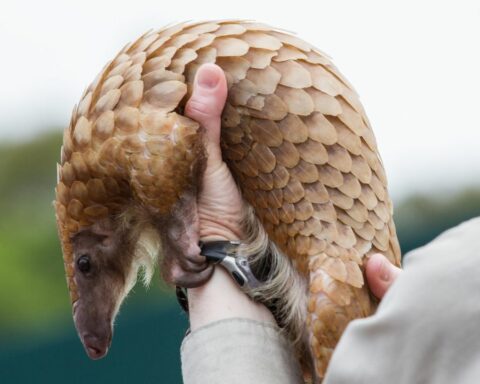Complete set of Flamingo Facts for Kids that will help you in learning all the Flamingos Information For Kids that you need to know. You are going to learn all about Flamingos, their scientific name, classification, appearance, physical features, diet, behavior, habitat, reproduction, adaptations, endangerment, and many other interesting facts about Flamingos.
Flamingo Facts for Kids
- Flamingos are tall pink wading birds found along the shorelines and mudflats. They are well-known for their long legs, long S-shaped neck, and bright color feathers.
- The bright coloration of flamingos is due to an organic pigment, the beta-carotene, found in their food sources.
- There are three genera and six species of living flamingos. Two species are native to Europe, Africa, and Asia, while four species are distributed throughout the Americas.
- Flamingos are filter feeders and eat blue-green algae, small crustaceans, insect larvae, etc. Their curved beaks and rough tongues are well-adapted for filtration.
- Flamingos are social birds and live in groups and large colonies. A flamingo colony may have thousands of individuals.
- Flamingos perform synchronized ritual displays during the breeding season, which include head-flagging, wing-salute, twist-preening, and marching.
- Like pigeons, flamingos feed their chicks with milk produced in the upper digestive tract of both males and females. The nutritional value of the flamingo milk is similar to that of the mammal’s milk.
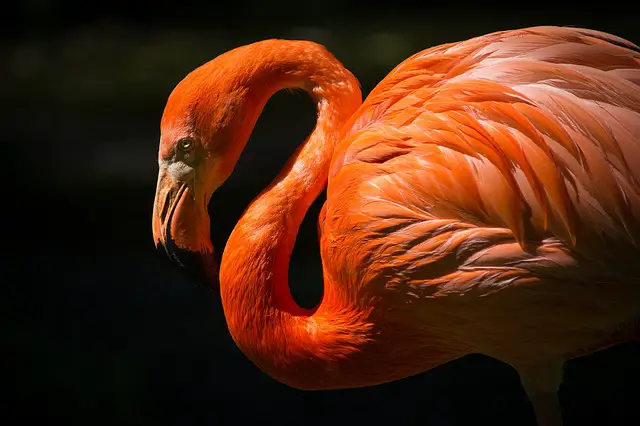
What Is A Flamingo
- The flamingos are tall pink wading birds found along the mudflats and shorelines.
- They are well-known for their stilt-like slender legs, long and graceful S-shaped necks, and pink feathers.
- They have webbed feet that allow them to run on water and gain speed before flying up into the sky.
- There are 3 genera and 6 species of living flamingos.
- Two species are indigenous to Asia, Europe, and Africa while the four species are found throughout the Americas.
- Two species of flamingos are Least Concern, three species are Near Threatened, while one species is listed Vulnerable on the IUCN Red List.
Scientific Name Of Flamingos
- The following are the scientific names of the flamingo species:
- Phoenicopterus roseus (greater flamingo)
- Phoeniconaias minor (the lesser flamingo)
- Phoenicopterus chilensis (Chilean flamingo)
- Phoenicoparrus jamesi (James’s flamingo)
- Phoenicoparrus andinus (the Andean flamingo)
- Phoenicopterus ruber (the American flamingo)
Scientific Classification Of Flamingos
- The following is the scientific classification or taxonomy of the flamingos:
| Domain | Eukaryota |
| Kingdom | Animalia |
| Phylum | Chordata |
| Subphylum | Vertebrata |
| Class | Aves |
| Order | Phoenicopteriformes |
| Family | Phoenicopteridae |
| Genus |
|
| Species |
|
Species Of Flamingos
There are 6 species of flamingos. The following is a brief description of all the six flamingo species.
- Greater flamingo (Phoenicopterus roseus) is found in southern Europe, in the Middle East, in Africa, and the Indian Subcontinent. It is the Old World flamingo species and is the largest of all the flamingo species.
- The lesser flamingo (Phoeniconaias minor) is the smallest of all the flamingo species. It is found in sub-Saharan Africa and northwestern India. Like the greater flamingo, it is also an Old World flamingo species.
- The Chilean flamingo (Phoenicopterus chilensis) is the New World flamingo species found in South America.
- James’s flamingo (Phoenicoparrus jamesi) is another New World flamingo found in the high elevation of Andean plateaus. This species is also known as the Puna flamingo.
- The Andean flamingo (Phoenicoparrus andinus) is also found in the Andean plateaus. It is also the New World flamingo and the rarest of its type in the world.
- The American flamingo (Phoenicopterus ruber) is the New World large flamingo species that is also known as the Caribbean flamingo. It is the only flamingo species that are naturally found in North America. It is closely related to the greater flamingo.
Evolution Of Flamingos
- Evidence shows that the evolution of flamingos occurred more than 30 million years ago.
- Morphological evidence and recent molecular studies suggest their strong relationship with grebes.
- The ancestor of flamingos and grebes (Mirandornithes) was Juncitarsus, which was probably a generalist feeder that lived during the early-middle Eocene in North America and Europe.
- The divergence of flamingos from grebes probably occurred sometime in the late Eocene in Europe.
What Does A Flamingo Look Like
Appearance
- Flamingos have a medium-size body, short tail, and large wings.
- They have long stick-like legs and a long S-like neck.
- They have small heads with small eyes, long beaks that curve downward, and small nostrils at the top part of the beak.
- Flamingos have webbed feet.
- Three species (greater, lesser, and Chilean flamingos) have three toes pointing in the forward direction and a hind toe or hallux. While the other species (James’s and Andean) lack hallux and just have three toes.
Color
- The plumage color of adult full-grown flamingos ranges from light pink to bright red.
- The ending part of their beaks is black while the rest is pink or red.
- The color of the legs and feet may be yellow-to-orange or pink-red depending on the species. The legs and feet of Andean flamingos are yellow.
- The bright coloration of flamingos is due to the beta-carotene they obtain from their food.
- Baby flamingos have greyish-red feathers.
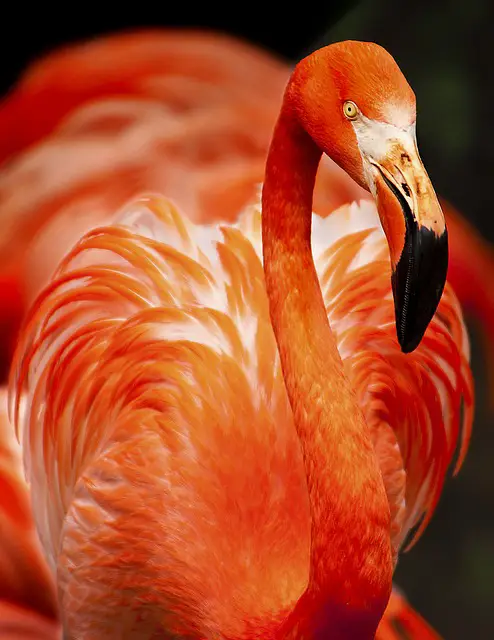
Physical Features
| S.No | Species | Height (feet) | Weight (kg) | Wingspan (feet) |
| 1 | Greater Flamingo | 3.9 to 4.7 | 2 to 4 | 4.9 |
| 2 | Lesser Flamingo | 1.2 to 2.7 | 2.5 | 3 |
| 3 | Chilean Flamingo | 3.6 to 4.3 | 2.5 to 3.5 | 3.9 to 4.9 |
| 4 | James’s Flamingo | 2.9 to 3.0 | 2 | 3.2 to 5.2 |
| 5 | Andean Flamingo | 3.2 to 4.6 | 4 | 3.25 to 5.25 |
| 6 | American Flamingo | 3.9 to 4.75 | 2.8 | 4.5 to 5.5 |
Physical Abilities Of Flamingos
Flying Speed
- Flamingos fly at the speed of 50 to 60 km/h (31 to 37 mph).
- When flying, a flamingo stretches out its head and neck in the front and draws its legs behind.
- To take off, a flamingo starts running for several steps to gain speed while flapping its wings and then lifts off into the air.
- When landing, they also run for several steps after touching the ground.
Swim
- Flamingos swim at the surface water of the seashores when water is beyond the depth of their wading.
- Their webbed feet allow them to swim. They are also often seen floating on the water surface.
- Flamingos can not dive and usually stay at the shores.
Sound
- Flamingos are very noisy birds and make several types of sounds, such as nasal honks, grunts, growling sounds, low gabbling sounds, alarm calls, and location calls in case of any danger.
What Do Flamingos Eat – Flamingos Diet
In Wild
- Flamingos are omnivores because they consume vegetation as well as small animal species.
- They eat blue-green algae, brine shrimps, crustaceans, mollusks, small insects, insect larvae, and many other small aquatic animals.
- They are filter-feeders and their beaks and tongues separate food from the mud and stilt.
- To feed, flamingos stir up the bottom of the water with their webbed feet and duck their bills down into the water to catch their food. They suck up the muddy water and filter food from it.
- Their food supply (especially the blue-green algae and red algae) has carotenoids that give them the pink or reddish color.
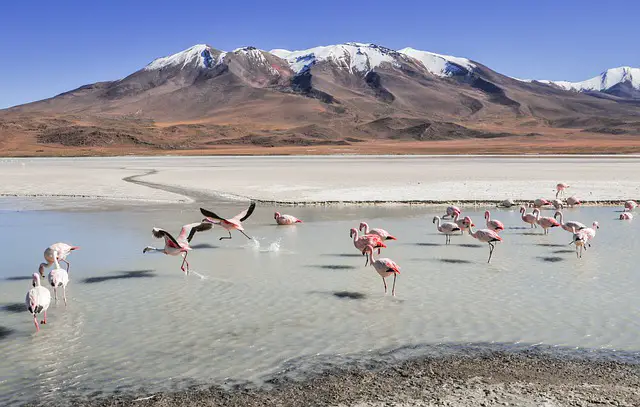
In Captivity
- In captivity, flamingos are fed with a commercial diet rich in carotenoids to preserve their bright coloration.
- In the beginning, zookeepers fed flamingos with dried shrimps, carrots, and red peppers.
- However, it was then found that their nesting and reproduction were more successful when synthetic carotenoid (canthaxanthin) was added to their diet.
List Of Food Items
The following are some of the major food items that flamingos eat:
- Blue-green algae
- Red algae
- Brine shrimps
- Crustaceans
- Mollusks
- Small fish
- Small insects
- Insect larvae
How Much Flamingos Eat Per Day
- Flamingos consume different amounts of diet depending on the species and their size.
- Lesser flamingos consume an estimated amount of 60 grams of food (dry weight) per day to fulfill their nutritional requirements.
- While the daily food requirement of the full-grown American flamingos is 270 grams in dry weight.
What Do Baby Flamingos Eat
- Baby flamingos consume special crop milk produced in the upper digestive tract of the parents.
- The crop milk contains proteins, fats, and red and white blood cells.
- Both the parents (mother and father) produce the milk and regurgitate it to feed the baby.
Where Do Flamingos Live – Flamingo Habitat
Natural Habitat
- The natural habitats of flamingos are large saline or alkaline lakes.
- They are also found in the estuarine lagoons usually with no vegetation.
- Flamingos use a variety of habitats. In the intertidal zone, they inhabit mangrove swamps, mud or tidal flats, and sandy islands.
- Due to the extremely salty or caustic waters, no other animals share their habitat in some regions besides small crustaceans, diatoms, and algae.
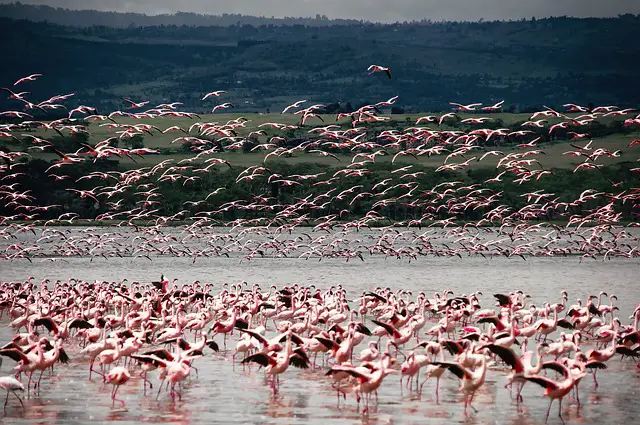
Biome
- Flamingos inhabit the aquatic biomes, which may be coastal waters, rivers and streams, brackish waters, lakes and ponds, and temporary pools.
Range
- Greater Flamingos’ habitat range covers parts of Africa and the Middle East, southern Asia, and southern Europe.
- The lesser flamingos’ habitat ranges in sub-Saharan Africa and northwestern India.
- The habitat range of Chilean flamingos covers parts in South America from Ecuador and Peru to Argentina, Chile, and Brazil.
- James’s flamingos’ habitat range is the Andean plateaus.
- The habitat range of the Andean flamingos is the South American Andes or Andean mountain range.
- The American Flamingos’ habitat range is the Caribbean Islands and the northern coastal regions of South America.
Countries List
- Greater flamingos are found in India, Pakistan, Bangladesh, Sri Lanka (southern Asia). United Arab Emirates, Iran, Bahrain, Kuwait, Cyprus, Lebanon, Turkey, Israel (Middle East). Albania, Greece, Italy, Montenegro, North Macedonia, Portugal, Spain, and southern regions of France (Europe).
- Lesser flamingos are found in Tanzania, Mauritania, Namibia, Botswana, South Africa, and India.
- Chilean flamingos are found in the South American countries; Ecuador, Peru, Argentina, Chile, and Brazil.
- James’s flamingos are found in Chile, Peru, Bolivia, and Argentina.
- The Andean Flamingos are found in Chile, Peru, and Argentina.
- The American flamingos are found in Colombia, Venezuela, Brazil, Cuba, Jamaica, the Bahamas, and the United States.
How Long Do Flamingos Live – Flamingos Lifespan
- The lifespan of all the living flamingo species is shown in the following table:
| S.No | Species | Lifespan In The Wild | Lifespan In Captivity |
| 1 | Greater Flamingo | 30 to 40 years | Over 60 years |
| 2 | Lesser Flamingo | 32 years (maximum) | 44 years |
| 3 | Chilean Flamingo | 50 years (average) | 40 to 44 years |
| 4 | James’s Flamingo | 20 to 30 years | Up to 50 years |
| 5 | Andean Flamingo | 20 to 30 years | Up to 60 years |
| 6 | American Flamingo | Up to 40 years | 60 years |
Flamingos Life Cycle
- The life cycle of a flamingo starts when it hatches from the egg.
- It gradually grows and reaches sexual maturity several years after hatching, usually at the age of 3 to 5 years.
- Flamingos start breeding at the age of about 6 years.
- They find mates and produce chicks every year.
- Flamingos live for an average age of about 40 years in the wild.
Flamingo Reproduction
- Flamingos are monogamous and form strong pair bonds. However, they sometimes change their mates in large colonies.
- Flamingo pairs establish and protect the nesting territories.
- To build a nest, the pair (or usually the female) choose a suitable site on the mudflats.
- Mating usually occurs during the nest building. Another flamingo pair sometimes interrupt the nest building trying to seize the site for their use.
- Flamingos protect their nesting site aggressively.
- Both mates cooperatively build the nest and protect the nest and egg.
- The females lay only one egg in a shallow hole at the top of the nest or mound.
- The egg of flamingos is slightly bigger than the chicken egg with 3 to 3.5 inches in size and 115 to 140 grams in weight.
- The incubation period lasts for about 27 or 31 days.
- The chick then hatches and both the parents take care of it.
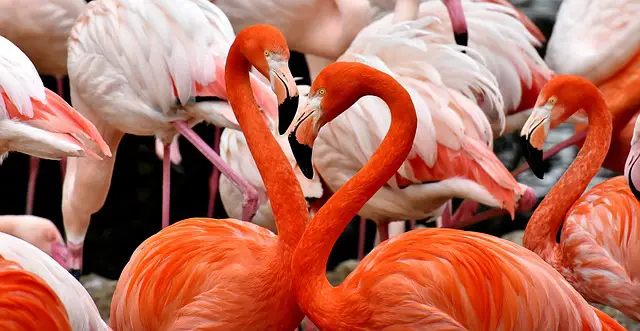
Flamingo Baby
- As the babies of other birds, a baby flamingo is known as a chick.
- A newly hatched chick has only 73 to 90 grams of weight and is about 2.7 inches in size.
- The body of the flamingo chick is covered with down feathers of grey color.
- The chick has a straight, pink beak and swollen pink legs. Its legs and beak then become black within a week.
- The chick stays in the nest or mound for 5 to 12 days after its hatch. During this period, both the parents feed it with crop milk produced in their upper digestive tract.
- At the age of 7 to 12 days, the chick starts moving out of the nest and exploring its surroundings.
- At the age of about 2 weeks, all the chicks are flock together in the small groups known as Microcrèches.
- After some time, the Microcrèches merge into large groups known as Crèches. A Crèche contains thousands of chicks.
- The chicks fledge (develop wing feathers and become capable of flight) at the age of about 75 days.
- They then become completely independent at the age of about 3 months.
- Young flamingos reach sexual maturity at the age of 3 to 5 years, depending on the species.
Behavior Of Flamingos
- Flamingos are social birds and live in groups known as flocks. A flock has an average number of 71 birds, however, it may have 2 to 340 individuals. Many flocks then merge into colonies. A colony may contain thousands of flamingos. It is believed that there are three intentions of living in such large colonies: to avoid predators, to maximize food intake, and to more efficiently use the hardly suitable nesting sites. Flamingos and chicks that become displaced from their groups are vulnerable to predators.
- Before breeding, the large colonies of flamingos split into small breeding groups of about 15 to 50 individuals. Both male and female flamingos in these groups perform ritual displays in a synchronized way. All the members of a group stand together and display to each other. The displays help flamingos to find mates that do not already have mates. It also stimulates the production of hormones and makes certain that as many flamingos breed as possible. The ritual displays also stimulate synchronized nesting. The ritual displays include;
- Head flagging, in which they stretch their necks and keep their heads up high and turn side to side rhythmically.
- Wing salute is shown off of the contrasting colors with tilting their tails and outstretching their necks.
- Twist preen, in which they twist their necks backward and seem to preen their feathers quickly with their beaks.
- Marching is the walk of a large, tightly packed group as one unit before changing their direction suddenly.
- Flamingos spend about 15 to 30% time preening. They spend most of their daytime feeding. They feed at the day or night time. Non-breeding individuals usually feed at night and spend their days in sleep or other activities, like preening or bathing in shallow water.
- When resting, flamingos may sit down and tuck their legs beneath their body or stand on one leg. They also face the wind while resting, which prohibits the wind and rain to penetrate their feathers. When standing on one leg, flamingos can be observed swinging back and forth in the wind.
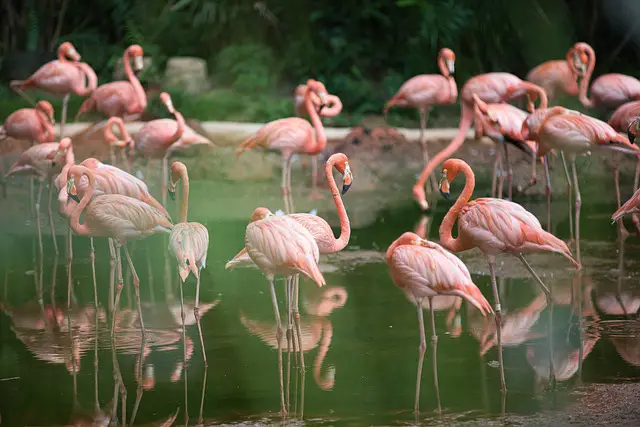
Flamingo Male Vs Female
- Male and female flamingos are about the same. The only difference between them is size. Male flamingos are slightly bigger than females.
Flamingo Adaptations
Physical Or Structural Adaptations
The following are some of the structural or physical adaptations of flamingos:
-
Long Legs
-
- Flamingos have long legs that are well-adapted for wading.
- Long legs allow them to wade in much deeper water than many other wading bird species.
-
Webbed Feet
-
- Flamingos have webbed feet that provide them support on soft mud.
- Webbed feet also allow them to swim on the water surface while feeding when water is beyond the depth of their wading.
- Webbed feet even make them able to run on the water when they are gaining speed before taking off into the air.
-
Long Neck
-
- The long necks of flamingos allow them to reach food deep underwater.
-
Special Beak
-
- Flamingos have special well-adapted beaks to filter and separate tiny food items from the mud and stilt.
- They use their beaks upside down, which is unique to them.
- Their large rough-surfaced tongue and mandibles have a covering of small hairy structures, known as lamellae.
- Lamellae assist in the filtering of food from muddy water.

-
Physiological Adaptations
The following are some of the physiological adaptations of flamingos:
-
Senses
-
- Flamingos have excellent hearing senses. This is an important adaptation because vocalizations are extremely important for flamingos, through which the parents and chicks recognize each other and the flocks stay together.
- Flamingos also have a good vision, which is important for taking part in the synchronized ritual displays.
-
Thermoregulation
-
- Flamingos are often seen standing at one leg.
- This posture is used for thermoregulation.
- When they curl one leg under the body, their curled feet become warm and conserve body heat.
- It also reduced the surface area to volume ratio, and in such a way their less body area is exposed to the environment and so less heat is released.
- However, flamingos stand on one leg in both cool and warm environments, that is why scientists doubt the role of this posture in thermoregulation.
-
Salt Glands In Nostrils
-
- Flamingos have salt glands in their nostrils that excrete salt when they drink salt-rich water. Because most of the lakes where flamingos are found have extremely high concentrations of salt.
- Flamingos also can drink water at boiling temperature. This is a special adaptation because boiling geysers is the only source of fresh water for some flamingos.
Flamingos Food Chain
In the food chain of flamingos, the Sun is the overall source of energy.
Producers
- Blue-green algae, red algae, and phytoplanktons are producers that take energy from the sun and prepare their food itself through photosynthesis.
Primary Consumers
- Flamingos are the primary consumers in this food chain and eat algae and planktons.
Secondary Consumers
- Secondary consumers are the predators of flamingos, such as vultures, eagles, crocodiles, and wild dogs.
Ecological Role Of Flamingos
- Flamingos eat organisms found in the shallow bodies of water.
- When feeding, they often stir up the bottom of the water with their feet, which allows the organisms to stir from the bottom up into the water.
- This activity possibly contributes to the mixing of organic material within these waters. It also aids in sufficient oxygenation and in avoiding anoxic conditions.
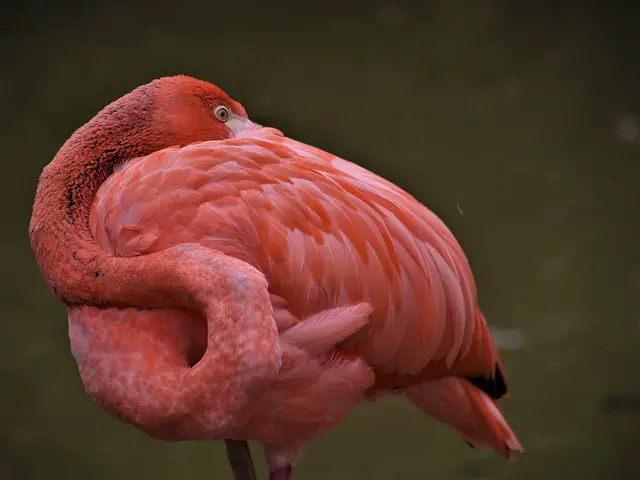
Flamingo Endangerment
Reasons
-
Pollution
-
- Pollution in the habitats of flamingos causes a threat to their survival. Like other aquatic animal species, plastic bags and other plastic garbage is a major pollutant for flamingos because it contaminates the soil and water where flamingos feed.
-
Habitat Destruction
-
- The construction of highways and roads causes the habitat destruction of flamingos because it makes their nesting and feeding grounds more accessible to humans and predators.
- In many flamingo habitats, the water level has been changed due to the irrigation of coastal desert.
- Mining activities of elements and minerals, such as lithium, potassium, boron, nitrates, and molybdenum, have caused serious disturbances in the flamingo habitats.
- Low-flying aircraft that bring photographers and bird enthusiasts into the feeding and nesting grounds harm the lifestyle of flamingos.
-
Conservation Status
-
- The conservation status of all the flamingo species is shown in the following table:
| S.No | Species | Conservation Status On The IUCN Red List |
| 1 | Greater Flamingo | Least Concern |
| 2 | Lesser Flamingo | Near Threatened |
| 3 | Chilean Flamingo | Near Threatened |
| 4 | James’s Flamingo | Near Threatened |
| 5 | Andean Flamingo | Vulnerable |
| 6 | American Flamingo | Least Concern |
Flamingo Predators
- Other bird species are the predators of flamingo eggs and chicks, such as eagles, Marabou stork, and vultures.
- While adult flamingos are killed and preyed on by other animals.
- Lions, cheetahs, leopards, jackals, and sometimes pythons prey on the lesser flamingos. While Geoffery’s cat and Andean fox prey Andean flamingos.
- In Africa, hyenas sometimes enter into the flamingo habitat when the ground is dry. Hyenas are known to cause more panic than actual mortalities.
- Records show that raccoons, bobcats, coyotes, foxes, dogs, and minks kill flamingos.
- Feral pigs are reported to prey on flamingos on the Great Inagua island in the Bahamas.
- It is estimated that about 5% of the flamingos die of predation at Lake Magadi in Africa.
- People prey on flamingos and use them as food. Their eggs are also eaten in some places, where it is removed from the nests and sold in markets.
Population Of Flamingos
- Of all the flamingo species, lesser flamingos are the most abundant with an estimated population of 1.5 to 2.5 million individuals.
- The greater flamingo is the second most abundant species. However, their exact population is difficult to estimate because of their wide range and migration patterns.
- Of the South American flamingos, the Chilean flamingos are the most abundant with an estimated population of 200,000 individuals. Their population is continuously declining.
- The estimated population of the James flamingos is 64,000 individuals.
- The population of Andean flamingos is estimated as 33,927 individuals. Their population trend is decreasing.
- The population of the Caribbean or American flamingos has been estimated as 850,000 to 880,000 individuals. Their population is currently stable and increased from the 1956 population of only 21,500 individuals.
Fun Facts About Flamingos
- The name FLAMINGO has been derived from the Spanish or Portuguese word flamengo, which means flame-colored.
- The pink or bright red coloration of flamingos is due to beta-carotene in their diet, especially the blue-green algae.
- Flamingos who eat only blue-green algae are darker in color than those who consume animals that have digested blue-green algae.
- Flamingos have a very poor or even no sense of smell. However, they have an excellent sense of hearing.
- The bright color of the flamingo feathers does not persist once it becomes shed from their body.
- Like pigeons, flamingos feed their babies with milk produced in their upper digestive tract. Their milk is similar to that of mammals in nutritional values.
- It is believed that the begging calls of the hungry flamingo chicks stimulate the production and secretion of the milk.
- The bright color of the parent’s plumage who feeds their baby drain to light pink or even white. They then gain their bright color back when the chick becomes independent and starts eating himself.
- In Ancient Rome, the tongues of flamingos were carefully prepared, pickled, and eaten as a rare delicacy.
- The silhouette of flamingos was used as the hieroglyphic for the red color in Ancient Egypt.
Faqs:
What Is The Meaning Of Flamingo
- Flamingo is a Spanish or Portuguese word, which means flame-colored.
What Is Flamingo’s Full Name
- Albert Spencer Aretz is the full name of an American YouTuber who is online known as Flamingo.
What Color Are Flamingos
- Flamingos have light pink to bright red colors.
What Is A Baby Flamingo Called
- A baby flamingo is called a chick.
What Eats Flamingos
- Many animal species like lions, cheetahs, leopards, jackals, raccoons, bobcats, coyotes, foxes, dogs, minks, eagles, and vultures eat flamingos.
- Humans also eat flamingos and their eggs.
What Turns Flamingos Pink – What Turns A Flamingos Feathers Pink
- Beta-carotene, which is an organic red-orange pigment found in the food sources of flamingos turns the feathers of flamingos pink.
What Color Are Flamingos Legs
- Flamingos have orange or pink-red legs.
- Andean flamingo is the only species that has a yellow color of the legs and feet.
What Color Are Flamingos When They Are Born
- Newborn flamingos have a greyish-red or greyish-white color.
What Happens If You Eat A Flamingo
- Nothing will happen if you eat a flamingo.
- The meat of flamingo is a source of protein and tests like a duck with a little fishy test.
What Color Is Flamingo Milk
- The milk of flamingos has a red color due to beta-carotene.
What Color Are Flamingo Eggs
- The newly laid egg has chalky-white color.
- However, it may become pale-blue after some time.
Where Are Flamingos Native To
- Two species of flamingos are native to Asia, Europe, and Africa.
- While the other four species are found in the Americas.


